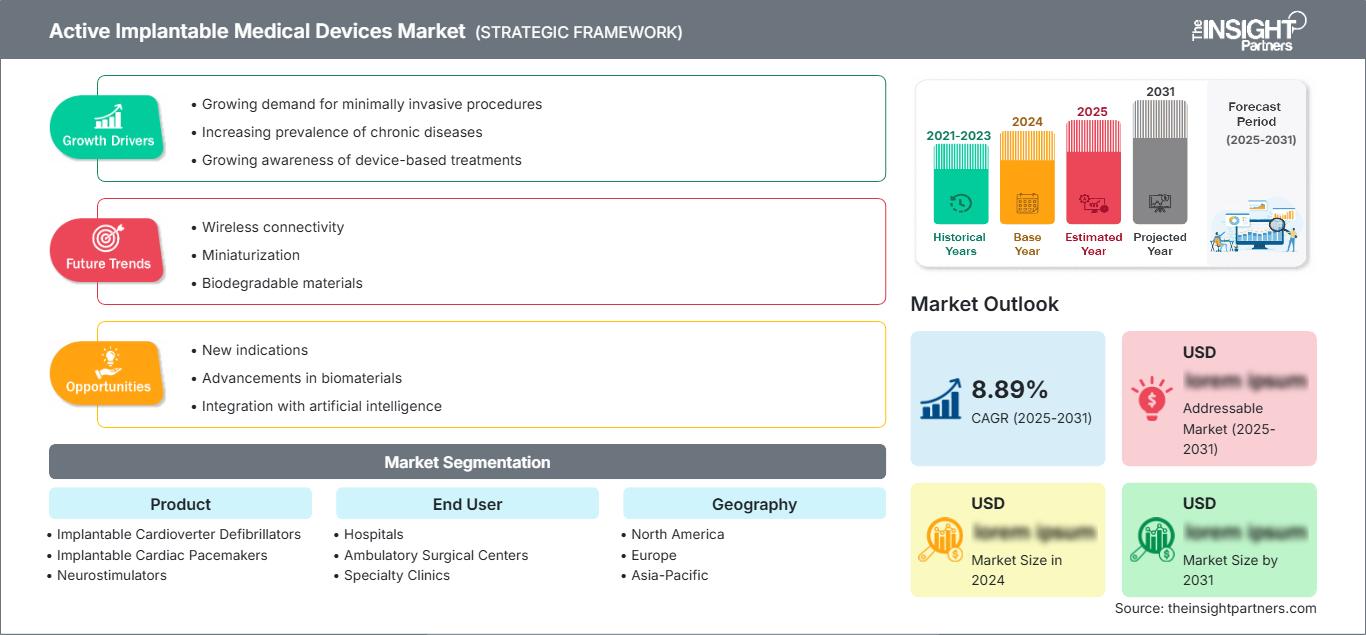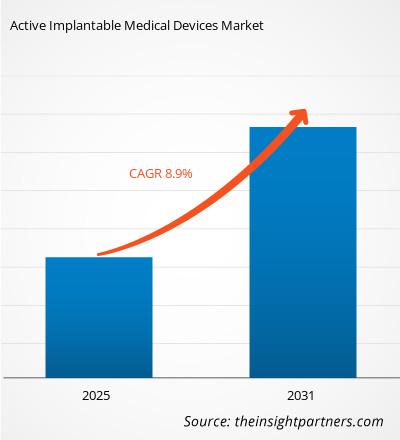Se prevé que el mercado de dispositivos médicos implantables activos registre una tasa de crecimiento anual compuesta (CAGR) del 8,89% entre 2025 y 2031, con un tamaño de mercado que se expandirá de XX millones de dólares estadounidenses en 2024 a XX millones de dólares estadounidenses en 2031.
El informe se segmenta por producto [desfibriladores cardioversores implantables (desfibriladores cardioversores implantables transvenosos y subcutáneos), marcapasos cardíacos implantables, neuroestimuladores, audífonos implantables, dispositivos de asistencia ventricular y monitores cardíacos implantables/registradores de bucle implantables] y usuario final (hospitales, centros quirúrgicos ambulatorios y clínicas especializadas). El análisis global se desglosa además a nivel regional y por países principales. El informe ofrece el valor en USD para el análisis y los segmentos mencionados.
Finalidad del informe
El informe «Mercado de dispositivos médicos implantables activos», elaborado por The Insight Partners, tiene como objetivo describir el panorama actual y el crecimiento futuro, los principales factores impulsores, los desafíos y las oportunidades. Esto proporcionará información valiosa a diversos actores del sector, tales como:
- Proveedores/fabricantes de tecnología: Para comprender la evolución de la dinámica del mercado y conocer las posibles oportunidades de crecimiento, lo que les permitirá tomar decisiones estratégicas informadas.
- Inversores: Realizar un análisis exhaustivo de las tendencias relativas a la tasa de crecimiento del mercado, las proyecciones financieras del mercado y las oportunidades que existen a lo largo de la cadena de valor.
- Organismos reguladores: Regular las políticas y controlar las actividades en el mercado con el objetivo de minimizar los abusos, preservar la confianza de los inversores y mantener la integridad y la estabilidad del mercado.
Segmentación del mercado de dispositivos médicos implantables activos
Producto
- Desfibriladores cardioversores implantables
- Marcapasos cardíacos implantables
- Neuroestimuladores
- Dispositivos auditivos implantables
- Dispositivos de asistencia ventricular
- Monitores cardíacos implantables/Registradores de bucle insertables
Usuario final
- hospitales
- Centros quirúrgicos ambulatorios
- Clínicas especializadas
Obtendrá personalización gratuita de cualquier informe, incluyendo partes de este informe, análisis a nivel de país y paquetes de datos de Excel. Además, podrá aprovechar excelentes ofertas y descuentos para empresas emergentes y universidades.
Mercado de dispositivos médicos implantables activos: Perspectivas estratégicas

- Obtenga las principales tendencias clave del mercado que se describen en este informe.Esta muestra GRATUITA incluirá análisis de datos, que abarcarán desde tendencias de mercado hasta estimaciones y pronósticos.
Factores que impulsan el crecimiento del mercado de dispositivos médicos implantables activos
- Creciente demanda de procedimientos mínimamente invasivos: Los dispositivos implantables activos, como marcapasos, desfibriladores cardioversores implantables (DCI) y neuroestimuladores, están diseñados para ofrecer opciones de tratamiento mínimamente invasivas a los pacientes.
- Aumento de la prevalencia de enfermedades crónicas: La creciente incidencia de enfermedades crónicas como la diabetes, la hipertensión y los trastornos neurológicos está impulsando la demanda de dispositivos implantables activos.
- Mayor conocimiento sobre los tratamientos basados en dispositivos: Los profesionales sanitarios y los pacientes reconocen cada vez más los beneficios de los tratamientos basados en dispositivos, que a menudo son más eficaces y rentables que las terapias farmacéuticas tradicionales.
Tendencias futuras del mercado de dispositivos médicos implantables activos
- Conectividad inalámbrica: La tendencia hacia la conectividad inalámbrica permite la monitorización y el control remotos de dispositivos implantables activos, mejorando los resultados para los pacientes y reduciendo los costes sanitarios.
- Miniaturización: El desarrollo de dispositivos más pequeños y compactos permite la implantación en múltiples sitios, mejorando la comodidad del paciente y reduciendo los riesgos quirúrgicos.
- Materiales biodegradables: El uso de materiales biodegradables está reduciendo el riesgo de complicaciones relacionadas con los dispositivos y permitiendo el desarrollo de implantes más complejos.
Oportunidades de mercado de dispositivos médicos implantables activos
- Nuevas indicaciones: Se espera que el descubrimiento de nuevas indicaciones terapéuticas para dispositivos implantables activos impulse el crecimiento del mercado.
- Avances en biomateriales: Se espera que el desarrollo de nuevos biomateriales con biocompatibilidad, durabilidad y funcionalidad mejoradas permita la creación de dispositivos implantables activos más sofisticados.
- Integración con inteligencia artificial: Se espera que la integración de la inteligencia artificial (IA) con dispositivos implantables activos mejore la precisión diagnóstica, los resultados del tratamiento y la participación del paciente.
Perspectivas regionales del mercado de dispositivos médicos implantables activos
Los analistas de The Insight Partners han explicado en detalle las tendencias regionales y los factores que influyen en el mercado de dispositivos médicos implantables activos durante el período de previsión. Esta sección también analiza los segmentos y la geografía del mercado de dispositivos médicos implantables activos en Norteamérica, Europa, Asia Pacífico, Oriente Medio y África, y Sudamérica y Centroamérica.
Alcance del informe de mercado de dispositivos médicos implantables activos
| Atributo del informe | Detalles |
|---|---|
| Tamaño del mercado en 2024 | XX millones de dólares estadounidenses |
| Tamaño del mercado para 2031 | XX millones de dólares estadounidenses |
| Tasa de crecimiento anual compuesto global (2025 - 2031) | 8,89% |
| Datos históricos | 2021-2023 |
| período de previsión | 2025-2031 |
| Segmentos cubiertos | Por producto
|
| Regiones y países cubiertos | América del norte
|
| Líderes del mercado y perfiles de empresas clave |
|
Densidad de los participantes en el mercado de dispositivos médicos implantables activos: comprensión de su impacto en la dinámica empresarial
El mercado de dispositivos médicos implantables activos está creciendo rápidamente, impulsado por la creciente demanda de los usuarios finales debido a factores como la evolución de las preferencias de los consumidores, los avances tecnológicos y una mayor conciencia de los beneficios del producto. A medida que aumenta la demanda, las empresas amplían su oferta, innovan para satisfacer las necesidades de los consumidores y aprovechan las tendencias emergentes, lo que impulsa aún más el crecimiento del mercado.

- Obtenga una visión general de los principales actores del mercado de dispositivos médicos implantables activos.
Puntos clave de venta
- Cobertura integral: El informe abarca de forma exhaustiva el análisis de productos, servicios, tipos y usuarios finales del mercado de dispositivos médicos implantables activos, proporcionando una visión holística.
- Análisis de expertos: El informe se elabora a partir del profundo conocimiento de expertos y analistas del sector.
- Información actualizada: El informe garantiza su relevancia para el negocio gracias a su cobertura de información reciente y tendencias de datos.
- Opciones de personalización: Este informe se puede personalizar para satisfacer las necesidades específicas del cliente y adaptarse adecuadamente a las estrategias comerciales.
Por lo tanto, el informe de investigación sobre el mercado de dispositivos médicos implantables activos puede ayudar a liderar el proceso de análisis y comprensión del panorama de la industria y sus perspectivas de crecimiento. Si bien existen algunas preocupaciones válidas, los beneficios generales de este informe tienden a superar las desventajas.
- Análisis histórico (2 años), año base, pronóstico (7 años) con CAGR
- Análisis PEST y FODA
- Tamaño del mercado, valor/volumen: global, regional y nacional
- Industria y panorama competitivo
- Conjunto de datos de Excel
Informes recientes
Informes relacionados
Testimonios
Razón para comprar
- Toma de decisiones informada
- Comprensión de la dinámica del mercado
- Análisis competitivo
- Información sobre clientes
- Pronósticos del mercado
- Mitigación de riesgos
- Planificación estratégica
- Justificación de la inversión
- Identificación de mercados emergentes
- Mejora de las estrategias de marketing
- Impulso de la eficiencia operativa
- Alineación con las tendencias regulatorias




















 Obtenga una muestra gratuita para - Mercado de dispositivos médicos implantables activos
Obtenga una muestra gratuita para - Mercado de dispositivos médicos implantables activos